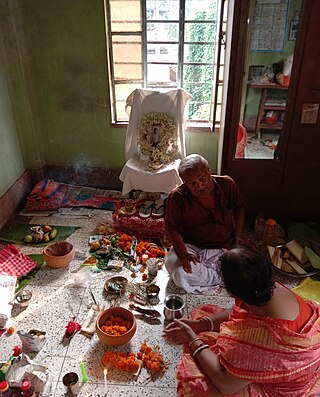Top Qs
Timeline
Chat
Perspective
Śrāddha
Sanskrit term for an act performed with faith (śraddhā) From Wikipedia, the free encyclopedia
Remove ads
Śrāddha (Sanskrit: श्राद्ध), is a ritual that some Hindus perform to pay homage to their pitṛs (dead ancestors).[1] They believe that the ritual would provide peace to the ancestors in their afterlife. It is performed on the death anniversaries of the departed as per the Hindu Calendar. In addition it is also performed for the entire community of 'pitr' – both from paternal and maternal side – collectively during the Pitri Paksha or Shraaddha paksha ('fortnight of ancestors'), right before Sharad Navaratri in autumn.[2][3][4]
This article needs additional citations for verification. (March 2024) |

Remove ads
Rituals
Summarize
Perspective

In practice, the karta (person who performs the Śrāddha):
(1) Invites Brahmanas (priests) that day, invokes in them the divinity of his/her parent, worships and feeds them.
(2) Performs a homa (fire ritual), appeasing Agni and Soma – the deities who transmit the offerings to the ancestors, nourish and protect them.
(3) Offers pinda (type of rice balls) to the departed souls ("pinda dana", offered to the Pitṛs, the ancestral spirits).The offerings are made to three generations i.e. father, grandfather and great-grandfather / mother, fathers' mother, fathers' grandmother.
(4) Crows are also revered in Hinduism and during Śrāddha the practice of offering food or pinda to crows is still current.[5]
The karta extends hospitality to the priest and concludes the ceremony by giving "dakshina" (fees) to the brahmanaas. (There are various other actions done to show respect to the Brahmanaas, like washing their feet etc. during the course of shraaddha).
Since this is one of the more important and noble "Saṃskāras" (rituals meant to cleanse the mind and soul) that the Hindu sages have envisaged, it is imperative that the performer of the ritual[6] understands what he or she is doing.[7] Only then will the true intent of the ritual be fulfilled and the performer of the ritual feel completely gratified. Otherwise, the ritual becomes just a mechanical exercise on one's part.
After death, the family performs the final rituals and holam. These rites are a reflection of a person's life. They may also include Santhi-homam and Agni-homam. After the Santhi-homam, the body is sprinkled with holy water to cleanse it. Other rituals include offering food and applying herbs to the body. The Havan is performed in order to appease the God of Fire, Agni. During the homam, verses are recited while the performer asks the god to forgive the deceased's mistakes and sins.[8]
Remove ads
The Śrāddha period
The scripture mandate performing 96 Śrāddha karmas. However, these practices are difficult to be adhered to. In addition, once in year offerings are to a larger universe of forefathers – during the pitr paksha. In Hindu amanta calendar ( ending with amavasya ), second half of the month Bhadrapada is called Pitri Paksha: Pitṛpakṣa or Śrāddha pakṣa and its amavasya ( new moon ) is called sarvapitri amavasya. This part is considered inauspicious in muhurtaśāstra (electional astrology). At this time (generally September) crops in India and Nepal are ready and the produce is offered as a mark of respect and gratitude (by way of pinda) first to the ancestors be they parents or forefathers before other festivals like Navaratri begin.
Many people visit Hindu pilgrimage sites to perform, Śrāddha ceremonies, like Pehowa, Kurukshetra, Haridwar, Gokarna, Nashik, Gaya etc. Haridwar is also known for its Hindu genealogy registers.
Remove ads
See also
- Antyesti
- Brahmin
- Hindu genealogy registers at Chintpurni, Himachal Pradesh
- Hindu genealogy registers at Haridwar
- Hindu genealogy registers at Jawalamukhi, Himachal Pradesh
- Hindu genealogy registers at Kurukshetra, Haryana
- Hindu genealogy registers at Peohwa, Haryana
- Hindu genealogy registers at Trimbakeshwar, Maharashtra
- Hindu genealogy registers at Varanasi
- Pitri
- Sandhyavandanam
- Vedic priesthood
- Śrāddha (Buddhadharma)
References
Further reading
Wikiwand - on
Seamless Wikipedia browsing. On steroids.
Remove ads
